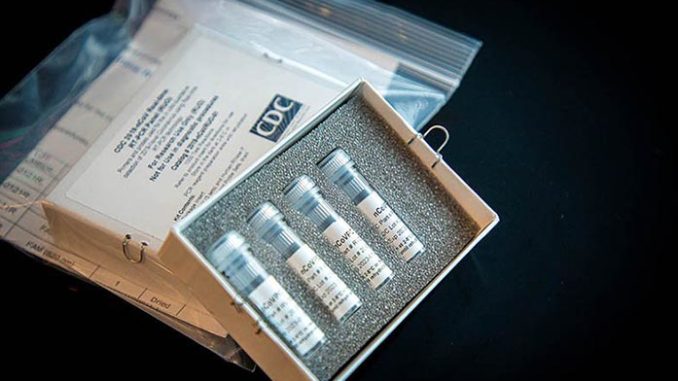
With public attention drawn last week to the fact that a COVID-19 “outbreak” can involve as few as two people testing positive in a two week period, similar attention is starting to focus on what is considered a positive test, what testing methods are available, and whether there is a difference between a positive “case” and a positive test result.
 But finding some of those answers isn’t easy, as Arizona Daily Independent found out last week. And when the answers are found, the meaning isn’t always what the average person might expect.
But finding some of those answers isn’t easy, as Arizona Daily Independent found out last week. And when the answers are found, the meaning isn’t always what the average person might expect.
At the end of October, the Arizona Department of Health Services (ADHS) announced nearly 6,000 new COVID-19 cases had been reported. The figure was based on new positive test results with no proof of how many of those people were sick in any way, whether the positive test result was correct, or if the person was even contagious anymore.
Of course those positive test results are only available because people undergo testing. But many do not even know which of the two common COVID-19 diagnostic tests they had.
According to the Harvard Medical School, PCR tests detect the presence of the virus’s genetic material (or viral RNA). A sample may be collected through a nasal or throat swab, or a saliva deposit, and is typically sent to a laboratory for processing.
While considered highly accurate, a PCR test can take several days for a result. The result can also be effected by whether the sample was collected and maintained properly until testing.
COVID-19 antigen tests, on the other hand, detect specific proteins on the surface of the coronavirus via a nasal or nasopharyngeal swab. Often referred to as rapid diagnostic tests, antigen tests can provide a result in less than one hour.
A positive antigen test is highly accurate, especially when the patient is in the early stage of infection when the viral load is highest. However, antigen tests can generate more a false negative than PCR tests, especially if the person has just become infected. And as the virus runs its course over several days, the person may no longer have a high enough antigen level to record as a positive.
“It may be helpful to think of a COVID antigen test as you would think of a rapid strep test or a rapid flu test,” the Harvard Medical School states. “A positive result for any of these tests is likely to be accurate, and allows diagnosis and treatment to begin quickly, while a negative result often results in further testing to confirm or overturn the initial result.”
Most PCR testing programs provide a positive or negative result based on a cycle threshold (CT) count. The Centers for Disease Control and Prevention (CDC) has listed a CT count of 40 as the highest acceptable CT count for a positive result, although the lower the count, the more genetic material is present in the sample.
When asked what the CT count is for Arizona’s PCR tests, a spokesperson for Arizona Department of Public Health wrote back that it “depends on the type of test used by a provider and the manufacturer recommendations for a particular test’s use.”
For instance, the Arizona State Public Health Lab primarily uses a specific COVID-19 PCR test kit manufactured by Thermofisher. Thermofisher’s test generates a positive result if the sample’s CT count is less than 37; a CT count greater than 37 generates a negative result.
“You would need to check with Arizona’s private labs to find out what FDA-approved tests they are using,” the ADHS said.
The state’s criteria may match up to some other states, but it has generated controversy among virologists, who are scientists and specialized medical doctors involved in the diagnosis, management, and prevention of infection.
One such scientist is Julie Morrison, PhD, who did her postdoctoral research at the Icahn School of Medicine at Mount Sinai. She recently told New York Times that she believes a PCR CT count should be 35 or lower to trigger a positive result.
“I’m shocked that people would think that 40 could represent a positive,” Morrison said.
Another concern virologists have with current PCR testing is that no one is paying attention to what a person’s CT count is, just whether the person is positive or negative.
“It’s just kind of mind-blowing to me that people are not recording the C.T. values from all these tests — that they’re just returning a positive or a negative,” Angela Rasmussen, a virologist at Columbia University, told the New York Times. “It would be useful information to know if somebody’s positive, whether they have a high viral load or a low viral load.”
But antigen tests have shortcomings as well.
In mid-September, ADHS Director Cara Christ announced a major change in how public health officials will report antigen test results. Until then, a positive antigen result was not counted unless the person had a known exposure or reported a COVID-19 symptom such as shortness of breath, cough, or sore throat.
With the change, anyone with a positive antigen test is now reported as a “probable case” even if the person has not been ill. Christ acknowledged antigen tests “may not be as accurate” as PCR tests, but argued “the quick results provide the ability to rapidly triage and make decisions.”
That decision has some in the medical profession concerned that Arizonans are receiving an overblown idea of how prevalent the infection rate it. A physician who has treated several COVID-19 patients at Canyon Vista Medical Center in Sierra Vista agrees, and hopes better diagnostic methods will be developed for persons who are not ill.
“After nearly eight months we are still requiring a lot of people to quarantine based on assumptions that someone else is infectious,” the doctor said Sunday. “We are closing our daycares, schools, public transit, even medical offices based on misleading data that perpetuates into more misleading data. It is having a discernable impact on the health and mental health of our community, especially our kids.”


